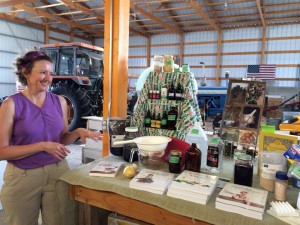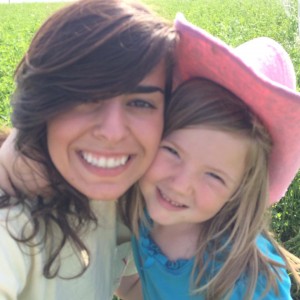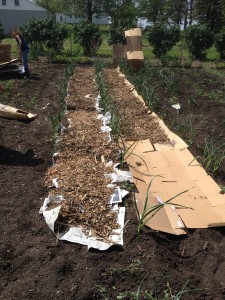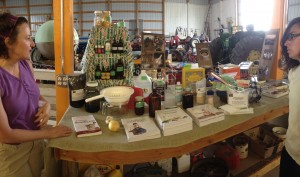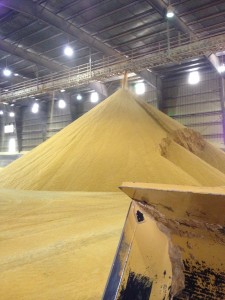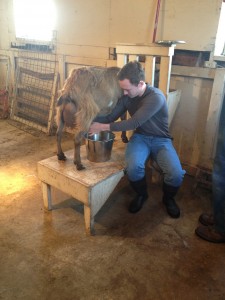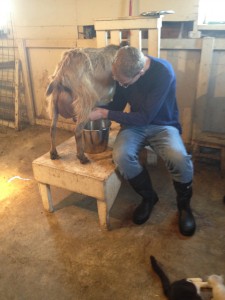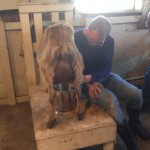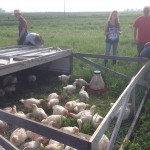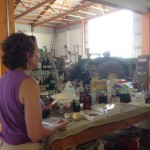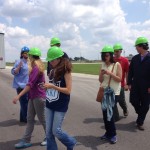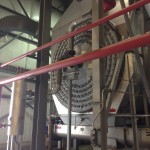Sorry for the temporary absence. For the past two days, we’ve gotten back relatively late, and Dr. HN let us move back our blog posts. How nice of him!
After a long day learning about cattle operations, we traveled to Des Moines to catch the one-night showing of Farmland, a documentary about the challenges of young farmers. I went into the theater knowing that it was sponsored by Big Ag companies, but I think the film did alright about not having an overt propaganda-style production. However, I did notice a few things that made me question a little about the film’s intent. Past the sappy score, I came to the conclusion that the film was very shallow in terms of its informational depth and kind of “Disney-fied.” There were lovely images of rolling farmland and hardworking individuals, but they only briefly mentioned some controversial issues, such as animal abuse and GMOs. The film didn’t delve into any of the more intricate criticisms of agriculture or the food system that other films, such as Food Inc, King Corn, and Fed Up, sought to advertise. By only interviewing farmers, I recognized that the film sought to humanize “Big Ag” practices without actually mentioning any company or group associated with Big Ag (although I did notice a lot of John Deere). Here is a film review that goes into further detail about the film and that I fully agree with.
The next day, we got to visit Summit Farms, a very large scale conventional farm. They prepared a presentation on their business and practices, most of which I didn’t completely understand. I really should have taken a business or another economics class at Furman, but that didn’t happen. They largely manage row crops, beef and pork in several states, and definitely subscribe to a “feed the world” mentality, but I’m sure the lucrative business aspects factor greatly in its expansion. While large agribusiness corporations like Summit do and should have the rights to function in society, they are largely attacked by many small and family farms and local food groups for their practices. The presentation included a table of how many lands they have found for sale (gathered by ads on craigslist, farmers newspapers, estates sale announcements, et cetera), how many were evaluated, how many were given an offer, and finally how many were actually bought. Farmer Denny and his friend, Caleb Knuttson (who is 90 years old and whose aunt died a few months ago at 110) were not too fond of Summit Farms. Their overall criticism described as, “When does it end?” Denny said that Summit has specialists in laws and practices or real estate and inheritance, and as soon as a farmer dies, they will be right on the doorsteps of the heirs. Denny doubts that the employees of Summit can answer that question as well. Unfortunately, we didn’t have enough time to actually tour the farm facilities. I would have liked to observe the operations of the large farms as compared to the small(-er) family-run farms that we’ve visited so far. After all, Summit operates 20,000 acres over three states.
The reason why we had to leave so quickly is that Dr. HN got an email from a farmer that he has been trying to contact for days. They were only available for today, but there was the small problem of their farm being two and a half hours away. Because that day was actually going to be a slow day, we decided to go for it. Blue Gate Farm is a small CSA and certified naturally grown farm that has vegetables, chickens, and…alpacas! I thought they did a wonderful job at describing the issues with being a small farm trying to make it in the world. They were only a few years old and only recently started making a profit. They claimed that their key to success was nonstop marketing and self-reliance, recognizing a need to build a strong, reliable customer base. However, I am growing more convinced that even despite the call for more people to join in on the farming industry, it is practically impossible to start a farm unless you were born into a farming family or have a tremendous amount of capital to offset the initial inputs. Every person that we’ve visited either went straight into farming on their own family farm or came back to farming on land that was given to them by family members. Blue Gate’s Jill and Sean were no exception. Even though they were theater majors and worked for most of their lives managing plays and other productions (including Wrestlemania of all things), they moved from Texas to Iowa to start farming on Jill’s grandfather and uncle’s acreage.
Today, we stopped by the FSA (Farm Services Agency) office to talk to representatives of the FSA, the Natural Resources Conservation Service, the USDA Rural Development Office, and the Iowa State Extension Office. First, we met with Rich Wragle from Iowa State Extension. As I learned today, each state has a land-grant school that has an “extension service” that focuses on four main areas: 4-H youth development, economic and community development, agriculture and natural resources, and human sciences. Basically, they have the answers to life, the universe, and everything. If they can’t help you, they at least point you to someone who can. Rich especially stressed that the extension office works to serve the community by forming partnerships with other entities, including municipalities, the university, and non-profits. Here is Clemson’s Extension. The representatives of the other offices, all parts of the USDA, gave us a rundown of the main programs that applied to farmers, including how to receive farm subsidies and loans, sustainable energy programs, and value-added product grants (value-added means irreversible modifications to a base product that adds value to the end product).
We also met with a representative of Niman Ranch, a pork purchaser that focuses on humane and traditional livestock raising. Their approach to raising pigs is no antibiotics, no added hormones, all vegetarian diet, outside access with shade, and large, padded huts. Pigs raised in this manner apparently have very high quality and tasty meat. Niman contracts with farmers across the U.S., and requires them to raise pigs in this manner to then sell them to their buyers. Their biggest buyers are Whole Foods, Chipotle, and high-end or naturally-raised oriented restaurants. However, Chipotle has expanded so quickly and demands so much meat that Niman can’t contract enough farmers to keep up! Although they were all about natural products, it seemed to be more about filling a niche market that demands humane treatment, rather than concern about the environment. They use GMO corn in their feed (which most producers out of cost savings, anyway) and they only require that their farmers follow the local and national environmental regulations. It was kind of an interesting turn because all of the other “alternative” farms that we’ve visited had some kind of pro-environment and/or local foods enthusiasm ingrained in their daily operations.
-
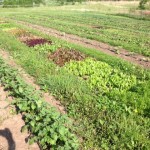
-
This was probably the prettiest and most organized vegetable garden I’ve ever seen.
-
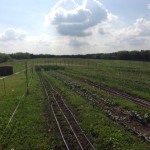
-
They had two different vegetable gardens separated by a windbreak so they are less likely to lose an entire crop if something were to happen, such as pesticide drift.
-
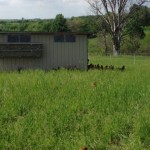
-
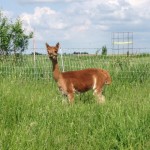
-
They had rather dismissive alpacas.
-

-
The newest member to the Blue Gate family.

